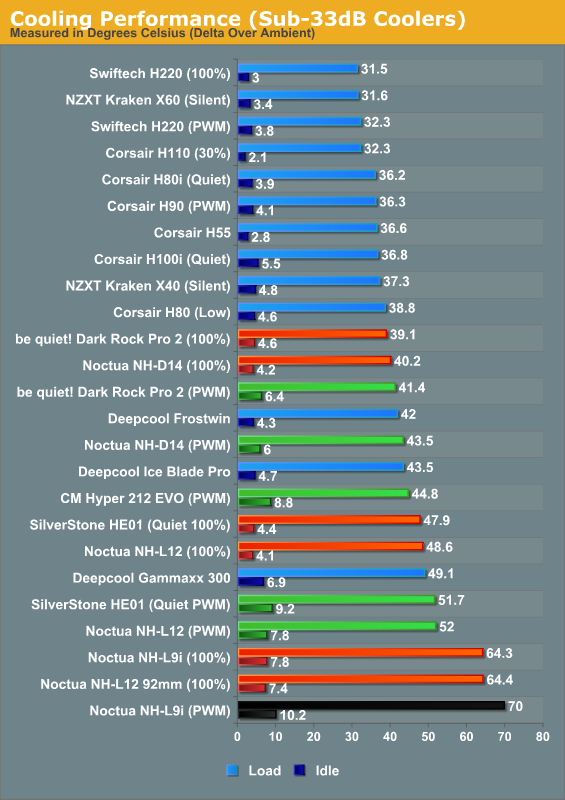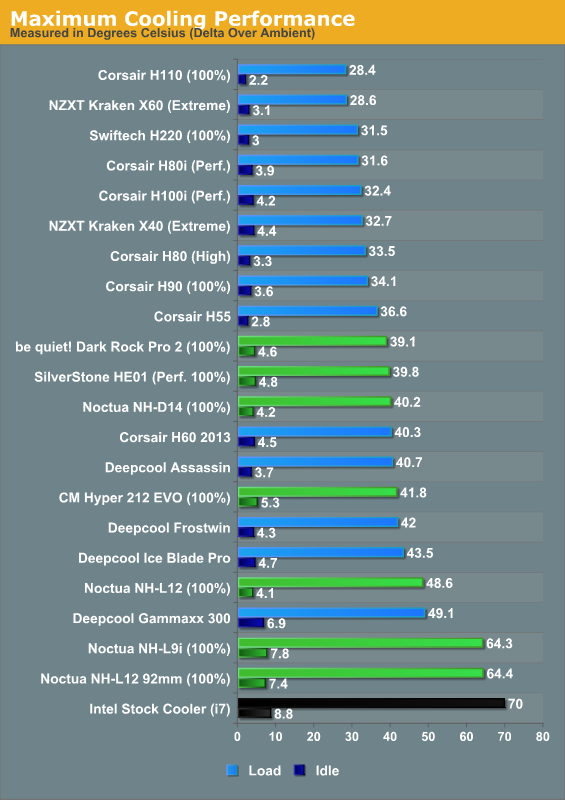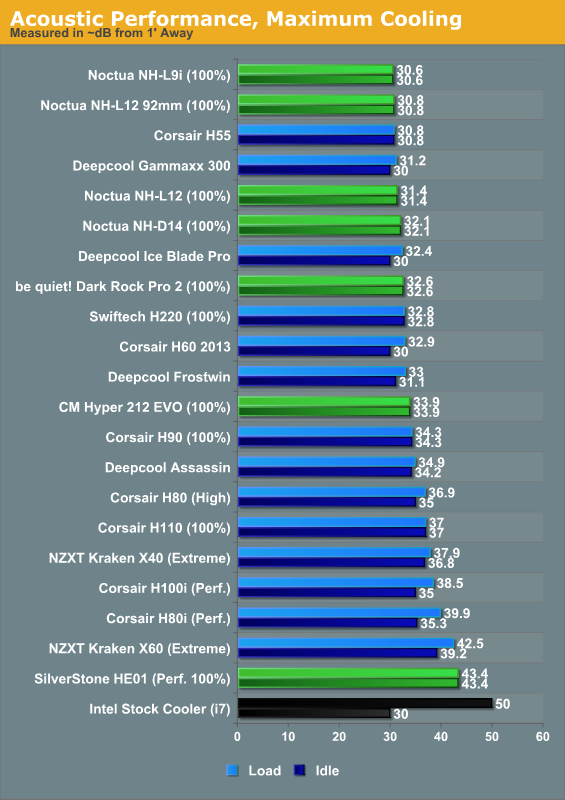CPU Air Cooler Roundup: Six Coolers from Noctua, SilverStone, be quiet!, and Cooler Master
by Dustin Sklavos on March 14, 2013 2:40 AM EST- Posted in
- Cases/Cooling/PSUs
- Cooler Master
- SilverStone
- cooling
- Noctua
- be
Silent Cooling Performance and Absolute Performance
Testing cases is in some ways much simpler than testing coolers, and a large part of that is because outside of an integrated fan controller, there's really not as much variability in the case's stock performance. Coolers, on the other hand, immediately benefit from the motherboard's fan control, and that has to be taken into account. They also have a more direct effect on the CPU's overall thermal performance. That means we need to break down the results into more useful metrics.
The first one is for silent performance. As a noise cap, I've chosen 33dB. Any coolers or settings that resulted in idle or load noise above 33dB have been pruned from the chart.

While every cooler I've tested today makes an appearance on this chart, the closed loop liquid coolers unfortunately have a clear advantage here. These are all quality units using excellent fans, though, and I'm keen to point out that you have to go to a 240mm or 280mm radiator before the closed loop units take a decisive lead. Generally speaking, you can get close to a 120mm or 140mm closed loop's cooling potential in an air cooler with comparable noise levels.
I'm keen to point out that Cooler Master's inexpensive Hyper 212 EVO actually does put in a pretty good showing here. Users on a budget would do well to note that it actually beats SilverStone's much larger Heligon HE01 when the Heligon's fan isn't cranked up.
With silent cooling broken down, let's take a look at the absolute maximum performance that can be gleaned from the coolers we've tested so far.

As it turns out, the closed loop coolers have a bit more headroom left in them compared to the majority of the air coolers tested. Our top performing trio is pretty much neck and neck for thermal performance, and even the Cooler Master Hyper 212 EVO is able to get awfully close to them. If you want high end air performance, you can definitely have it at a good price.

Of our big winners, though, Noctua and be quiet!'s solutions prove to be the quietest. SilverStone's Heligon may be able to produce comparable thermals, but that 38mm thick fan has to do an awful lot of grunt work to get there.










63 Comments
View All Comments
garadante - Friday, March 15, 2013 - link
I actually imagine that in the 240/280mm closed loop coolers, there's easily more than .25 liters of coolant. Perhaps even approaching a liter or more, depending on the size/density of radiator piping and the tubing.If your numbers are closer the accurate, than that's a fair enough way to say 15 minutes is likely enough, but still, I'd like to see 30-60 minute tests for the best performers, or even longer. Run those 280mm radiators for 1-2 hours and see how much/if at all that affects performance. Because on that slight change that it -does- affect it significantly, these numbers posted in the review are absolutely meaningless and misleading.
coffeejunkee - Friday, March 15, 2013 - link
Well, interesting results to say the least. Tom's Hardware and X-bitlabs have reviews up as well comparing aio's to NH-D14 and Phanteks PH-TC14. Their results are quite different from this. For example in the X-bitsreview the H55 is easily beaten by PH-TC14 but here the H55 does better than the NH-D14. Something's not right, and it's probably called outtake fan.Nfarce - Friday, March 15, 2013 - link
Just remember that there are a lot of variables in different entities testing the same cooler, not the least of which is hardware including the case itself, and the success of how well the coolers are attached to the CPU with paste to minimize gaps. Then you have ambient temperature and altitude differences, etc. I wouldn't trust one review to be better or worse than another review of the same cooler. You are better off trying to find a pattern among all the coolers tested you are interested in and see which one mostly stays on top.coffeejunkee - Saturday, March 16, 2013 - link
Well, yes that's the reason I comment. I read many cooler reviews and I'm aware you can't compare them on an absolute basis, too many outside variables for that. But the results of this one have me scratching my head. This is simply the first time I see an aio like H55 do better than the NH-D14 and it just doesn't make much sense to me. I mean, look how thin the H55 radiator is and then look at the massive 1 kg of copper and aluminium which is the NH-D14. Ok, so H55 has higher rpm fan, but the dual fan setup on the NH-D14 counters that.Also, Hyper 212 is a nice heatsink if you can get it around $30 but just 1.6 degree difference vs NH-D14? Which weighs like twice as much and has 2 fans, one even a 140mm model? Maybe using the NH-L12 bracket isn't so ideal afterall (also might be nice to mention regular NH-D14 doesn't come with pwm fans).
mapesdhs - Friday, March 15, 2013 - link
I wish you'd included the Phanteks PH-TC14PE. It's cheaper than the NH-D14, looks nicer
and in many reviews performs better.
Ian.
Nfarce - Friday, March 15, 2013 - link
I've been loving my NH-D14 on a 4.8GHz 2500k for two years solid now. Even in summer indoor ambient temps of 80F (27C), it never gets above 55C at that high level o/c running 1.38v. Of course the modded Antec Nine Hundred it sits in has excellent airflow too.And two years ago I paid $85 for the thing, so the price has not come down at all, which speaks volumes about the continued demand for them. Best $$ I ever spent under $100 on a piece of hardware.
Havor - Saturday, March 16, 2013 - link
I don't get all the bias of the reviewer against the NH-L9i, yeah for normal PC use its pretty much useless, but thats not ware its made for.Its a HTPC/small form factor cooler, and it fits in to places ware its big brothers don't fit, its real competition is the Scythe Shuriken series and some other low profile solutions.
Lycros - Saturday, March 16, 2013 - link
Anyway you can use the same fan(s) across all of the heatsinks next time?ellroy80 - Sunday, March 17, 2013 - link
Dustin, your review of the NH-L9i is really not fair. It states on the Noctua website that "The NH-L9i is a highly-compact low-profile quiet cooler designed for use in small form factor cases and HTPC environments. While it provides first rate performance in its class, it is not suitable for overclocking and should be used with care on CPUs with more than 65W TDP." So your usage scenario is really not applicable to this cooler. Any chance you could re-test it with, say, an i3-3225?lichoblack - Monday, March 18, 2013 - link
I have to agree that the review paints the cooler in bad light, but instead of using another CPU, I'm more game with changing the restrictions: test small coolers and see how they fare. The NH-L9i/L9a have a very low height, and you can use them in very, very restrictive cases (thinking of an htpc/emu case using a Lian-Li PC-Q12, then you can only use a cooler up to 55mm, so you can use a stock intel fan, but not an AMD stock fan. see:http://www.lian-li.com/v2/en/product/product06.php... Not many coolers fit this bill, and big air just doesn't fit this. CLC could, depending on the case, but big air can't. So more small aftermarket coolers so we can better paint the small air picture :)